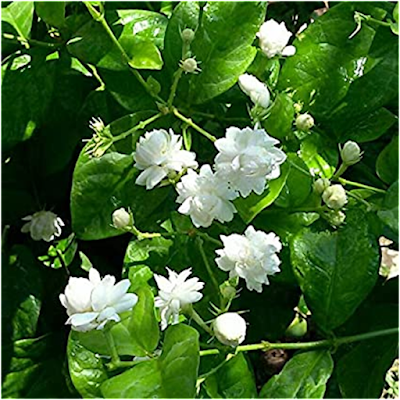Jasmine
No other flower probably has such a heavenly and easily recognisable, unique fragrance. This makes the small jasmine flower one of the most popular flowers in the world. The name jasmine comes from the Persian word ‘yasmin,’ meaning gift from God, and the flower, undoubtedly Asian in origin, is thought to have originated in the Himalayas in Western China. Some garden historians however believe that Persia, (present day Iran) is where the jasmine originated. Eventually, the fragrant flower crossed the Red Sea into Egypt with travellers as early as1000 B.C, and then migrated to Turkey and Greece.
The jasmine, which
is the national flower of Indonesia, the Philippines, Syria, Pakistan, Thailand
and Japan, is native to the tropical and warmer temperate regions of the world.
There are over two hundred species of this delicate, star-like flower, and most
of them are white, though there are a few varieties that are pale yellow.
The jasmine is
a climbing shrub that grows to a height of eight to ten feet. It has a slender,
delicate stem, and evergreen or deciduous leaves. The plant needs bright sunlight
and warmth to flourish. In the 1400’s, the jasmine was considered a ‘royal’
flower, and was planted for the kings of Afghanistan, Nepal, and Persia.
This beautiful
and popular flower is used in a variety of ways in the different lands where it
is grown. In the first century AD, Dioscorides, a Greek physician and author of
a treatise on medicinal herbs wrote that the Persians used jasmine oil to perfume
the air in their banquet halls. Jasmine oil is made in India, Egypt, China, and
Morocco, and this oil is used to make incense, perfume, and cosmetics like
soaps and shampoos. In Hawaii, the jasmine flower is used to make leis
(Hawaiian garlands). In Javanese weddings, this flower is commonly used for
hair and dagger decorations for the bride and the groom.
One of the
most important uses of the jasmine is medicinal. This small fragrant flower is
considered to be a powerful herb, useful in the treatment of numerous ailments,
and is widely used in aromatherapy, and Ayurvedic medicine. In many places,
including the United States, jasmine syrup is used to make marshmallows, and the
flowers are used in churches along with other altar flowers to make the air
fragrant.
Jasmines are
popular as gifts not only because of their wonderful fragrance and beauty, but
because they are thought to attract heavenly angels, wealth and health, promote
healing, and calm the nerves. They make great gifts for friends and family
members, and especially for those who are night owls, as most varieties of this
flower tend to unfurl and display their beauty only late at night.
The coral
jasmine, which is the official flower of the state of West Bengal in India, is
also used as a source of yellow dye for clothing. Jasmines are also used to
make jasmine tea, a kind of delicately scented tea which uses jasmine blossoms
for aroma. This tea is a very popular beverage in China, and goes back to the
days of the Sung dynasty (960-1279 AD). Since the jasmine is a versatile flower,
it can be blended with any type of tea leaves, and is commonly blended with green
tea, although white and other jasmine teas exist as well. In China, jasmine tea
is traditionally offered as a welcome drink to guests. Jasmine tea is today prized
the world over as a health drink, since it is thought to reduce the risk of cancer
and high cholesterol.
On the sacred
Mount Athnos in Greece, jasmine is grown and used in incense, which is hand rolled
by Byzantine Greek Orthodox monks. Jasmine incense is also used in Greek
religious ceremonies and for thanksgiving. In India, the jasmine is often referred
to as ‘queen of the night,’ because of the unique and distinct fragrance the
flower typically gives off at night.
The flower’s
Sanskit name is ‘Mallika.’ The Latin name for the jasmine shrub is Nyctanthes
arbortristis. The nyctanthes refers to the fact that the flowers bloom only at night,
and drop to the ground when the sun rises, and arbor-tristis means ‘sad tree,’
referring both to the forlorn look of the flowerless specimen. The jasmine is
also the sacred flower of Kama, the Hindu god of love, so jasmines are widely used
in wedding rituals and as wedding garlands.
In Thailand, jasmines are considered to be symbolic of a
mother’s love; the flower’s pristine white colour is thought to be as pure as
the love a mother has for her child. On the12th of August, the birthday of the
Queen of Thailand, the people of Thailand celebrate ‘Mother’s Day.’ On this
day, jasmines are widely used as decorations in Thailand. The Thai people use
garlands sewn with jasmines, called phuang malai as offerings to Buddha or to
elders, or as gifts for good luck.
In Cambodia, jasmines
are used as sacred offerings to the Buddha, and jasmine buds and flowers are also
used in decorative displays for temples, festivals, holidays, and weddings.
Monks add jasmines to holy water, which is used for blessings.
Do you know?
* When Vasco da Gama returned from his travels in the
sixteenth century, he brought home a small, fragrant, white jasmine plant from
the Far East.
* Mysore mallige, a variety of jasmine mostly grown in
and around Mysore in the state of Karnataka was a favourite flower of the
Wodeyars, erstwhile rulers of Mysore. They used it extensively during their
spectacular Dassera celebrations every year.
* Jasmines are the favourite flowers of Nobel Laureate and
celebrated Burmese leader Aung San Suu Kyi. She often wears them in her hair,
and did so during her recent visit to India.

















